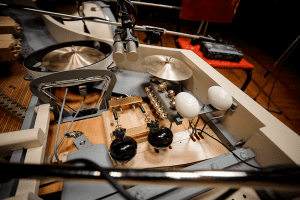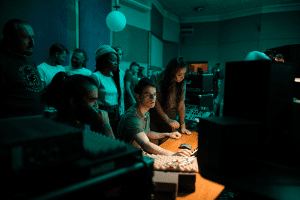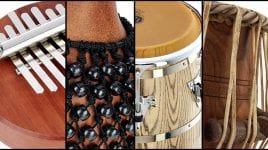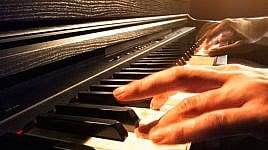
#ThePowerOfMusic
The band Brunettes Shoot Blondes had a great idea: to modify a piano from the 19th century. One piano was transformed into a machine that accommodates 20 different instruments. You might already be asking yourself many questions: What does it look like? How does it sound? How do players operate this monster?
You’ll find the answers in the video for their song “Houston” below. We’re sure you’ll be amazed…
You are currently viewing a placeholder content from Youtube. To access the actual content, click the button below. Please note that doing so will share data with third-party providers.
MAKING OF
Below is a short description of how they built their super-instrument, from the words of Andrew Kovaliov (musician, songwriter, music video director, concept creator)…
We got lucky to find this 19th century grand piano in a small town in the Western Ukraine. It appeared to have been out of use for a long time. The funny thing was, just bringing it to Kiev, along with its transportation within the city, ended up costing almost as much as the instrument itself.
The best thing about this vintage piano, was the body construction. None of us knew much about the difference between the old and new models so it was simply a matter of luck that we stumbled upon this one. Most modern pianos have cross-shaped string-holders, leaving a comparatively small place for anything else to be put in between. In our case the piano’s body had only two parallel cast-iron barriers with some thin wood and a lot of free space, in case you needed to get rid of the strings.
This eventually brought us to the idea of dividing the piano roll into three sections:
- Central section. The actual piano
- Left section. Violas, Cello, Organ, Xylophone
- Right section. Percussion
The instrument organization
The central section hasn’t changed much except a few strings in the lower part which had to be replaced. Since only the middle register strings were saved, we had no bass tones. The only solution to keep some low sounds was to replace the first piano section octave with some bass strings. Also, the sustain pedal moved to the left leaving some extra space for somebody who would sit to the right.
The right section was appointed to house all the percussion instruments. The mechanism here is the same as the one used for the piano section. Whenever pressing certain keys, the hammers strike the other side. Only, instead of hitting strings, the hammers now strike tambourines, cymbals, etc. Our teammate and DOP, Kirill Svetashov, suggested some keys could be paired not with the opposite hammers, but with ones further out. When the two connected to each other, you can press one key but get a sound from a different place.
The shakers are also connected to the keys but they produce the sound two times: on press and on release. The chimes, on the other hand, are a one-time deal. When pressing the far right key, a fixed clothespin releases a thread. A counter-weight on the other side falls down, pulling a small hook through the chimes.
The left section was the tricky one. We spent a lot of time searching for the right engineers to help figure out how the strings and organ could work together. Two violins, a cello, organ and harmonica all ended up working from rotating a sewing machine’s mechanism. In case of the strings, it makes little wheels spin very fast when laying down on the neck, thus producing a sound that imitates the bow rubbing.
We were limited with our selection of notes, since one wheel could work only with one note and one string. We were left with 4 cello and 4 violin notes.
The organ and melodica are also connected to the spinning mechanism. However, the sound is being produced differently. Here we have a pump and bellows producing the air required for the instruments to sound off. You can’t immediately start playing organ, you need to start building up air in the container up a few seconds in advance.
Additional instruments
In the meantime, some extra instruments were added. A kick drum and hi-hat were set on a side of the piano. A person sitting right can normally play it by pressing foot pedals. A xylophone was placed in the left section, producing sound from the striking hammers. A kalimba and metallophone were basically pasted into the piano frame.
We didn’t want to put big microphones in it, so we went with 17 small and mid-sized ones, so that all the instruments and small details wouldn’t be obscured in the video. We wanted to make everything live, so all the microphones were recording the instrument simultaneously.
About the band
Brunettes Shoot Blondes is an indie rock band based in Kiev, Ukraine. Formed at the beginning of 2010, they attracted music lovers’ attention with their songs.
In September 2014 the band released a self-produced music video for the song Knock Knock which immediately became a worldwide viral hit. With over 10 million views on YouTube, it was called an Internet sensation and was positively reviewed by such media giants as Billboard, Yahoo! Music, The Daily Mirror, USA Today, Mashable, Business Insider, Daily Mail and many others.
At the end of 2014 Brunettes Shoot Blondes presented a new video for the song called Bittersweet. The video, made in partnership with Opel Germany, was directed by the band, like the previous one.
The band’s songs and videos are now on rotation on various radio and TV stations. The musicians have already performed numerous shows and festivals in their homeland and on the stages of Europe.
Check out the band online:
3 comments
Leave a Reply
You are currently viewing a placeholder content from Facebook. To access the actual content, click the button below. Please note that doing so will share data with third-party providers.
More InformationYou are currently viewing a placeholder content from Instagram. To access the actual content, click the button below. Please note that doing so will share data with third-party providers.
More InformationYou are currently viewing a placeholder content from X. To access the actual content, click the button below. Please note that doing so will share data with third-party providers.
More Information

















t says:
#KyivNotKiev
n says:
#KyivNotKiev
River says:
#KyivNotKiev